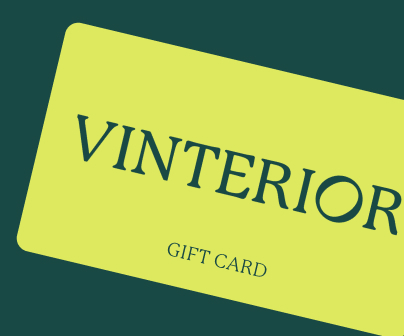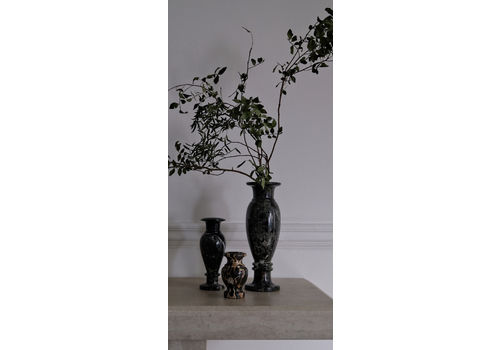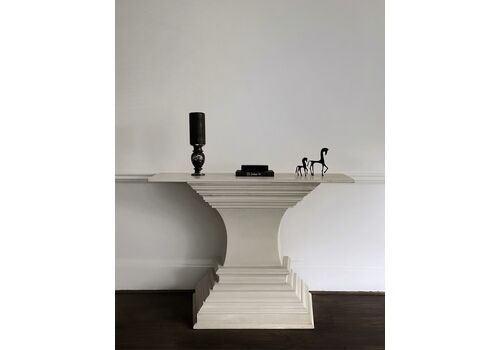Schneider, Mid Century Modernist Crystal Table Lamp By Charles Schneider, 1950
SOLD
Shopping at Vinterior
-
14-day return guarantee
-
Outstanding customer service
-
Secure payment
-
Buyer protection
-
Trees planted for every purchase

Item details
Height
33.5 cm
Width
14.0 cm
Depth
14.0 cm
Wear conditions
Excellent
Wear conditions
Excellent
Shows little to no signs of wear and tear.
Good
May show slight traces of use in keeping with age. Most vintage and antique items fit into this condition.
Average
Likely to show signs of some light scratching and ageing but still remains in a fair condition.
Apparent Wear and Tear
Visible signs of previous use including scratches, chips or stains.
Please refer to condition report, images or make a seller enquiry for additional information.
Description
Schneider mouth-blown crystal lamp with biomorphic form is in almost perfect condition given its age. A rare piece of history. Stamped.
Matching candle holders sold seperately.
The Schneider Glassworks (Verreries Schneider), established by brothers Charles and Ernest Schneider in Epinay-sur-Seine, France, in 1917, was among the leading producers of fine-art glass between the two world wars, creating exuberantly colorful vessels and lighting fixtures in both the Art Nouveau and Art Deco styles. The factory’s highpoint was the 1920s, when it created iconic chandeliers and exquisitely decorated cameo glass vases that are still in high demand today.
Born in the last quarter of the 19th century in Château-Thierry, near Paris, Charles and Ernest Schneider moved with their family at a young age to Nancy, a major center of Art Nouveau design, particularly known for glass. Among the city’s master makers was the crystal studio Daum, where both brothers worked at the turn of the 20th century, Ernest in sales, and Charles receiving training in the engraving and decoration workshop, while concurrently learning drawing and modeling with Henri Bergé and attending the École des Beaux-Arts in Nancy. In 1904, he enrolled at the École Nationale Supérieure des Beaux-Arts, in Paris, where he studied painting and metal engraving and regularly showed in the engraving section of the Salon de la Société des Artistes Français, twice receiving a prize.
Around 1912 the brothers and their friend, architect Henri Wolf, bought a small glass factory specializing in lightbulbs, renaming it Schneider Frères et Wolff. The partners enticed a group of about 20 workers from the Daum workshop to join the company, which produced high-quality cameo vases and lamps until the outbreak of World War I, in 1914, when Charles, Ernest and most of the workers were called up to fight. The Schneiders were demobbed in 1917 and reopened the factory, initially making practical glassware for hospitals. After the war, to fund their reentry into the art-glass market, they sold shares in the company, now named the Société Anonyme des Verreries Schneider. The success of the elegant drinking glasses and Art Nouveau-style cameo vases they produced allowed the brothers to buy back the shares, at which point they renamed the factory Verreries Schneider.
When a fire destroyed the Gallé studios in 1918, the Schneiders offered space to a group of the company’s artists so they could continue production. In return, they taught Charles marqueterie de verre. Similar to wood marquetry, this process involves cutting sections out of a glass surface and filling them with pieces of a contrasting color. In 1921, Schneider trademarked his technique for making cameo glass lamps and vases — exemplified in this piece from the early 1920s — which he signed “Le Verre Français” or “Charder,” the latter perhaps a portmanteau combining his first and last names. These works were popular and sold well at France’s top department stores, including Galeries Lafayette and Le Bon Marché. More elaborate, one-of-a-kind pieces from the studio were signed “Schneider” and offered at Paris art galleries like Au Vase Etrusque and Delvaux.
The Schneiders participated in the 1925 Exposition Internationale des Arts Décoratifs et Industriels Moderne in Paris, at which Charles was a member of the jury. The company was at its peak, expanding both its design repertoire and the number of workers, to 500. During this period, it began moving away from the organic shapes of Art Nouveau to the more geometric designs of Art Deco, with some pieces embodying a kind of transitional style, such as this chandelier. Charles also began experimenting with pigmented powders, fine crushed glass mixed with metal oxides, which yielded brilliant, iridescent colors when applied to a glass surface.
A large portion of the factory’s art glass production was sold in the United States. When the U.S. stock market crashed in 1929, demand was all but obliterated, and the company struggled to stay afloat throughout the 1930s. Ernest died in 1937, and during World War II, the factory was seized by German troops and used as a canteen. In 1950, Charles and his son set up a new factory called Cristalleries Schneider in Epinay-sur-Seine, which for several years produced free-blown glass vases, small sculptures and lighting fixtures to some acclaim. Charles Schneider died in 1952, and the factory eventually closed in 1981.
Condition report:
Great condition. A few minuscule flaws photographed as best possible.
Cancellations
We offer free cancellations and full refund for orders cancelled before dispatching. View full policy.
Returns
We have a 14-day return guarantee for orders from individual sellers, within the UK and European Union. View full policy.
Estimated delivery time
Less than one week
Free collection available
Yes
More from this seller
More from this seller
Choose a Wishlist
Create Wishlist
- Selling at Vinterior since 2022
- 31 sales
- Ships from Glasgow, United Kingdom
Seller Reviews

Verified Purchase


Verified Purchase


Verified Purchase

Cancellations and Returns
Last updated: 24th March 2025
We want everybody’s Vinterior experience to be seamless, so both buyers and sellers can fall in love with pre-loved. We designed our Terms of sale to treat everybody fairly.
However, sometimes things don’t go exactly to plan, and you may need to cancel or return an order.
To prevent this, we encourage you to check listings, photos and descriptions carefully before you buy. If you aren’t sure about a piece’s condition, size, provenance or shipping, just ask; click Contact seller to get in touch. Always contact your seller first if you have any queries, at any point in your purchase.
Our buyers receive the same protection when buying from all our sellers, both professional and verified.
Can I cancel an order?
There are many reasons why you might need to cancel an order, and you'll often be entitled to a refund. To cancel an order, click Create cancellation on the order page.
If you cancel your order before it has been dispatched, you will receive a full refund - including delivery costs. However, if your item has been shipped, delivery costs will not be included in your refund.
Please note: orders of bespoke, personalised or made-to-order pieces cannot be cancelled.
Can I return an order?
We understand that sometimes a piece isn’t the perfect fit. So if you no longer want your order, our returns process will ensure it finds a new home fast.
The Vinterior Guarantee included with your purchase entitles you to 14-day returns - allowing you to return any item within 14 days of the delivery date (except in specific circumstances, detailed below).
You can return your order if...
It isn't what you expected
If what arrives isn’t what you ordered, you can open a return. Just send us some photo evidence that the listing was inaccurate, misleading or misrepresented your purchased piece, and you’ll receive a refund.
You change your mind
If you don’t feel a piece is right for your space, you can return it. Once you request a change of mind return, you’ll be responsible for shipping the piece back to your seller as soon as possible. Delivery costs are non-refundable.
It's damaged in transit
In the rare event that an item arrives damaged or defective, you have a full 30 days from the date of delivery to return it for a full refund.
If your purchase arrives broken, always let us know. If Proovia delivered the piece, we can raise an insurance claim on the seller’s behalf. Or, the seller can raise a claim with their chosen courier.
What can't I return?
Just as there are some orders you can’t cancel, there are some you cant return, too. Personalised, bespoke or made-to-order pieces are non-returnable, and non-refundable. Sellers may also reject your return if the item has been altered in any way.
Please note: pieces on our site are pre-loved, not new. They may show some wear and tear; this is not sufficient grounds for a refund, unless the seller has misrepresented the item’s condition.
Lastly, neither Vinterior nor our sellers are liable for any damages or loss sustained in transit via third parties.
I'm eligible for a return. Now what?
To initiate a return, log into your Vinterior account, then go to the relevant order page and click Create a return. In the return request, be sure to include all the details: the reason for your return, an in-depth description, and photos of any issues or damage.
How will I receive my refund?
Once the seller confirms they’ve received the item (in the same condition it was sent), we will send your refund to your original payment method.
All items are inspected on return. If the seller receives the return with damage they don’t recognise, we will not be able to process your refund and the seller may need to send the piece back to you. You will be required to cover these delivery costs.

















